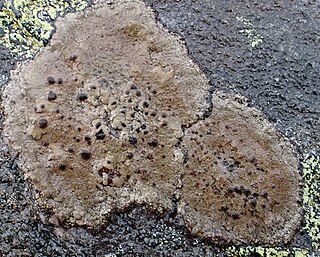Scutula is a genus of lichenicolous fungi in the family Ramalinaceae.

The Lecanorales are an order of mostly lichen-forming fungi belonging to the class Lecanoromycetes in the division Ascomycota. The order contains 26 families, 269 genera, and 5695 species.

The Lecanoraceae are a family of lichenized fungi in the order Lecanorales. Species of this family have a widespread distribution.
Adelolecia is a genus of crustose lichens in the family Lecanoraceae. The genus was circumscribed by Hannes Hertel and Josef Hafellner in 1984. The genus was formerly classified in the family Ramalinaceae, but molecular phylogenetic analysis showed it to belong to the Lecanoraceae.

The Acarosporaceae are a family of fungi in the order Acarosporales. Members of this family have a widespread distribution, and are mostly lichenized with green algae. According to a 2021 estimate, the family contains 11 genera and about 260 species. The family is characterised by a hamathecium formed of paraphysoids.

Pycnora is a genus of fungi in the monotypic family Pycnoraceae. It contains three species. The genus was circumscribed by Josef Hafellner in 2001; the family was proposed by Mika Bendiksby and Einar Timdal in 2013.

Fuscideaceae is a family of lichen-forming fungi in the order Umbilicariales. It contains five genera and about 55 species of crustose lichens.

The Lecideaceae are a family of lichen-forming fungi in the order Lecideales. It contains about 30 genera and roughly 250 species. A major distinguishing characteristic of the family is the lecanoroid form of the fruiting bodies: typically circular, dark, and without a thalline margin. Most species in the family are lichenised with green algae, although a few species, scattered amongst several genera, are lichenicolous—they live on other lichens. Lecideaceae lichens tend to grow on rocks, wood, and soil. Several Lecideaceae species accelerate the weathering of rock surfaces, a process known as pedogenesis, by extending their hyphae into cracks and expelling rock flakes. This contributes to significantly faster weathering rates in certain environments, impacts various materials from natural rocks to man-made Sekishu roof tiles, and involves key biomolecules identified for survival and biodeterioration, including compounds to withstand intense ultraviolet radiation.

Hypocenomyce is a genus of lichen-forming fungi in the family Ophioparmaceae. Species in the genus grow on bark and on wood, especially on burned tree stumps and trunks in coniferous forest. Hypocenomyce lichens are widely distributed in the northern hemisphere.

Mycoblastus is a genus of crustose lichens in the family Tephromelataceae. Members of the genus are commonly called blood lichens.

Palicella is a genus of crustose lichens in the family Lecanoraceae. It contains six species.

The Tephromelataceae are a family of lichenized fungi in the order Lecanorales. The family was circumscribed by Austrian lichenologist Josef Hafellner in 1984. Tephromelataceae comprises the genera Tephromela, Calvitimela, Mycoblastus and Violella, which together constitute a well-supported monophyletic group.

Malmideaceae is a family of crustose and corticolous lichens in the order Lecanorales. It contains eight genera and about 70 species.

Hertelidea is a genus of crustose lichens in the family Stereocaulaceae. Characteristics of the genus include carbon-black ring or outer margin (exciple) around the fruit body disc (apothecium), eight-spored, Micarea-type asci and mostly simple, hyaline ascospores that lack a transparent outer layer. Hertelidea species mostly grow on wood, although less frequently they are found on bark or soil. While the type species, Hertelidea botryosa, has a widespread distribution, most of the other species are found only in Australia.

Schaereria is a genus of lichen-forming fungi. It is the sole genus in the family Schaereriaceae, which itself is the only family in the Schaereriales, an order in the subclass Ostropomycetidae of the class Lecanoromycetes. Most Schaereria species are crustose lichens that live on rocks. Schaereria was first proposed by Gustav Wilhelm Körber in 1855 and was later taken up by other lichenologists despite periods of disuse.

The Rhizocarpales are an order of lichen-forming fungi in the subclass Lecanoromycetidae of the class Lecanoromycetes. It has two families, Rhizocarpaceae and Sporastatiaceae, which contain mostly crustose lichens.
Tephromela lignicola is a species of lignicolous (wood-dwelling), crustose lichen in the family Tephromelataceae. It is found in the Falkland Islands, where it grows on fenceposts and similar timber.
Violella wangii is a widespread, but seldom-collected species of crustose lichen in the family Tephromelataceae. Found in mountainous areas of Bhutan, China, India and the Russian Far East, it was formally described as a new species in 2011 by lichenologists Toby Spribille and Bernard Goffinet. The type specimen was collected from Laojunshan Mountain in the Shennongjia Forestry District at an altitude between 3,510 and 3,900 m ; there, in a montane forest of mostly Abies and Rhododendron, it was found growing on the bark of Rhododendron. In the Russian Far East, it has been recorded growing on the wood of Pinus pumila. Thin-layer chromatography of collected specimens showed the presence of three lichen products: atranorin, roccellic acid, and angardianic acid. The species epithet wangii honours Dr. Wang Li-Song, "for his ongoing efforts to describe the lichen diversity in western China".
Timdalia is a fungal genus in the family Acarosporaceae. It is a monotypic genus, containing the single species Timdalia intricata, a saxicolous (rock-dwelling), crustose lichen. This species was first formally described by Swedish lichenologist Adolf Hugo Magnusson in 1935, based on a collection made by Eduard Frey in Austria. It was initially classified in the genus Acarospora. Josef Hafellner circumscribed Timdalia to contain the species in 2001. It was initially placed in the family Lecanoraceae, but molecular phylogenetic studies showed Timdalia to belong in the Acarosporaceae. The genus name honours Norwegian lichenologist Einar Timdal.
Helocarpaceae is a family of lichen-forming fungi in the subclass Lecanoromycetidae. The family is monotypic, and contains the single genus Helocarpon.















